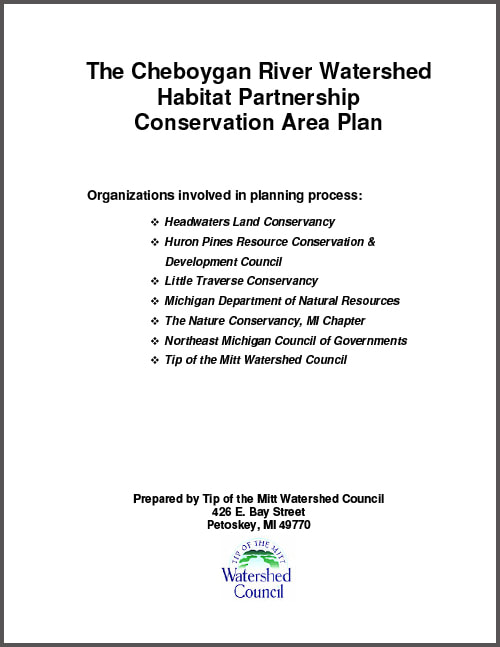Cheboygan River Watershed Habitat Partnership Conservation Area Plan
|
Executive Summary
The Cheboygan River Watershed supports habitat for high-quality terrestrial and aquatic biodiversity and provides important commodities for the resource and tourist-based economy of the northern Lower Peninsula. The landscape is characterized by large, inland glacial lakes, wild rivers and large forested areas that provide habitat for a variety of species, both common and rare. While much of the Watershed is in state ownership, many sensitive areas along lakeshores and riparian corridors are in private ownership. The Cheboygan River Watershed Habitat Partnership was created to bring together several agencies and organizations dedicated to the protection of the Watershed’s natural resources including: Tip of the Mitt Watershed Council, Little Traverse Conservancy, The Michigan Chapter of the Nature Conservancy, Northeast Michigan Council of Governments, Headwaters Land Conservancy, The Michigan Department of Natural Resources, and Huron Pines Resource Conservation & Development Council. Over the course of several months these partners developed this conservation plan in an effort to devise strategies to preserve biological diversity throughout the Watershed in a comprehensive and complementary manner. |
Following the model outlined in “The Five-S Framework for Site Conservation: A Practitioner’s Handbook for Site Conservation Planning and Measuring Conservation Success” (The Nature Conservancy, 2001), the planning team identified a set of ecological targets and values that provide the basis for conservation activities in the Watershed. These targets are: bogs, fens and hardwood -conifer swamps, Michigan monkey-flower, Hungerford’s crawling water beetle, lakes and associated wetlands, lakes and streams in karst terrain, ground water-driven streams and riparian corridors, and wildlife corridors and core habitat. In spite of historical and ongoing impacts from human activities, these targets and the ecological processes that support them remain relatively intact. The overall healthy condition of the conservation targets is reflected in the “Good” biodiversity health assessment rank.
The primary sources of stress impacting the conservation targets are residential development, roads and utilities, dams, increased imperviousness, and shoreline alteration and hardening. While these threats are projected to increase given continued expansion of residential, commercial, and recreational development in the region, numerous opportunities exist to minimize the impacts of human activities and to educate both residents and visitors to the Watershed on the importance of natural resource protection. The planning team identified 16 strategies to address threats to the conservation targets. Six of these were selected for immediate development and implementation: stabilizing and upgrading road/stream crossings, coordinated land protection, establishing and enforcing sound planning and zoning, implementing shoreline best management practices (BMPs), promoting economic benefits of resource protection, and retrofitting existing developed areas to reduce polluted stormwater runoff.
The primary sources of stress impacting the conservation targets are residential development, roads and utilities, dams, increased imperviousness, and shoreline alteration and hardening. While these threats are projected to increase given continued expansion of residential, commercial, and recreational development in the region, numerous opportunities exist to minimize the impacts of human activities and to educate both residents and visitors to the Watershed on the importance of natural resource protection. The planning team identified 16 strategies to address threats to the conservation targets. Six of these were selected for immediate development and implementation: stabilizing and upgrading road/stream crossings, coordinated land protection, establishing and enforcing sound planning and zoning, implementing shoreline best management practices (BMPs), promoting economic benefits of resource protection, and retrofitting existing developed areas to reduce polluted stormwater runoff.




